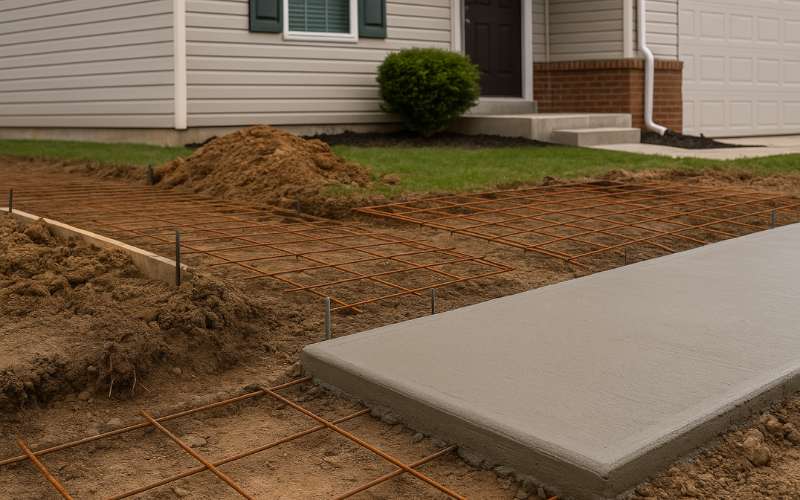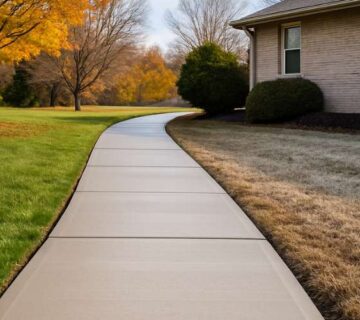Sidewalks may appear simple, but their construction requires careful planning and precision. The Importance of Proper Grading and Reinforcement in Sidewalk Construction cannot be overstated, as these elements directly impact durability and safety. A poorly built sidewalk often leads to cracks, uneven surfaces, or water pooling, creating hazards for pedestrians. By focusing on correct grading and reinforcement, contractors can prevent these issues, extend the lifespan of sidewalks, and reduce costly repairs for property owners.
Why Grading and Reinforcement Are Essential in Sidewalk Construction
Sidewalks play an essential role in connecting communities, increasing property value, and ensuring safe pathways for pedestrians. Unfortunately, many sidewalks fail sooner than expected because grading or reinforcement was not done correctly during construction. Proper grading lays the groundwork for water drainage and stability, while reinforcement provides the strength concrete needs to endure pressure and stress. When these two aspects are combined, sidewalks become stronger, safer, and far more resistant to damage, ultimately saving time and money for both homeowners and municipalities.
Why Proper Grading Matters
Grading is the foundation of every sidewalk project, and when neglected, the results can be problematic. Without proper grading, sidewalks often crack, shift, or develop areas where water collects. Over time, this trapped water weakens the base and accelerates damage, leading to expensive repairs. A well-graded sidewalk ensures water drains away from the concrete surface, maintaining both strength and stability. When contractors prioritize grading, they create a solid base that supports the entire structure, helping sidewalks remain functional and safe for years to come.
Preventing Drainage Issues
One of the most common reasons sidewalks fail is improper drainage, which leads to cracks, sinking sections, and uneven walking surfaces. By designing sidewalks with correct grading, contractors can direct water away from the surface and prevent it from pooling underneath the concrete. This not only protects the sidewalk itself but also reduces damage to nearby structures and landscaping. Proper drainage ensures that rainwater flows naturally, preserving the soil beneath the sidewalk and extending the lifespan of the entire installation. Investing in good drainage practices during construction prevents costly issues in the future.
The Role of Reinforcement
While grading establishes stability, reinforcement provides the strength needed for sidewalks to withstand daily use. Concrete, although strong in compression, can easily crack when exposed to heavy loads or pressure. Reinforcement, such as steel bars or wire mesh, strengthens the concrete by distributing weight evenly and preventing small cracks from spreading. This extra support ensures sidewalks hold up under foot traffic, bicycles, or even vehicles when installed in driveways. Without reinforcement, sidewalks are more vulnerable to damage and deterioration, which often leads to costly and frequent repairs.
Types of Reinforcement for Sidewalks
Sidewalk reinforcement can be achieved in several ways, each designed to meet different needs and budgets. Steel rebar offers unmatched strength and is ideal for sidewalks exposed to heavy traffic or frequent loads. Wire mesh, on the other hand, is more affordable and works well for lighter use, making it a popular choice for residential areas. Another option is adding fibers directly into the concrete mix, which helps reduce surface cracking and improves overall durability. Choosing the right type of reinforcement depends on soil conditions, location, and the level of expected traffic. With the right choice, sidewalks remain strong and resilient for years.
Combining Grading and Reinforcement
Grading and reinforcement must work together to deliver lasting results. A properly graded base prevents soil movement and ensures that the surface stays level, while reinforcement adds strength to handle weight and resist cracks. When combined, these two practices create sidewalks that are durable, safe, and cost-effective in the long run. For homeowners and communities, this means fewer repair bills, reduced risks of accidents, and pathways that remain attractive and functional for decades. Proper planning and execution ensure that sidewalks are built not only for today but also for the future.
Common Mistakes in Sidewalk Construction
Even experienced contractors sometimes make mistakes that reduce the life of a sidewalk. Skipping soil testing before grading, using poor reinforcement materials, or neglecting water runoff are some of the most common errors. These oversights may not show immediate problems but often lead to long-term damage and costly repairs. By addressing these issues early, contractors can avoid unnecessary complications and ensure sidewalks perform as expected. Attention to detail, proper materials, and an understanding of the environment all contribute to successful, long-lasting results.
Benefits of Proper Grading and Reinforcement
Investing in proper grading and reinforcement provides numerous benefits that make sidewalks safer, stronger, and more cost-efficient. Cracks and repairs become less frequent, allowing homeowners and municipalities to save money on maintenance. Well-built sidewalks also provide safe and reliable surfaces for pedestrians, reducing the risk of accidents. Beyond safety, a long-lasting sidewalk enhances curb appeal and property value, contributing to the overall beauty and functionality of a neighborhood. These benefits highlight why it is essential to prioritize proper construction methods from the start.
How Professionals Ensure Success
Professional contractors achieve success by following a careful process that includes soil testing, precise grading, and choosing the best reinforcement method. Each step is important, and when done correctly, the result is a sidewalk that stands the test of time. By understanding the environment and traffic conditions, professionals select the materials and designs that work best for each project. This careful planning ensures sidewalks remain stable, attractive, and durable, delivering value for property owners and safe pathways for the community. As a result, professional workmanship becomes the key to long-lasting success.
Build Stronger Sidewalks Today
The Importance of Proper Grading and Reinforcement in Sidewalk Construction is clear—these practices are essential for strength, safety, and durability. When sidewalks are built with proper planning, they last longer, resist damage, and remain safe for everyone. Don’t wait until cracks or uneven surfaces appear. Contact our experienced team today to discuss your project and let us create sidewalks that protect your investment while enhancing the beauty and value of your property.





No comment